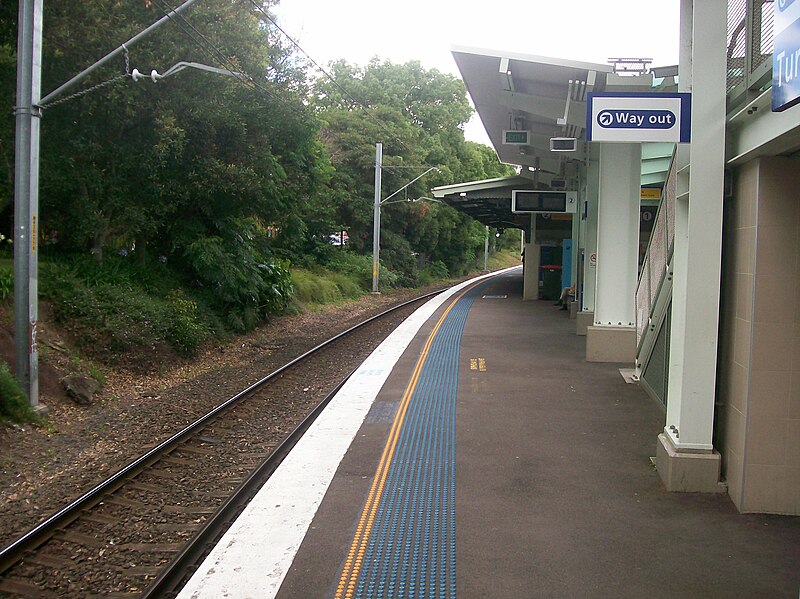About this Cache
This cache is a container with a slight twist: technique is more important than strength. Please ensure that you sign the log - merely finding the container is not enough as gaining access to the log is part of the challenge / fun (but BYO Pen)! Parking can be problematic around this area, but it is close to public transport ...
Being a commuter station usage is concentrated around the morning, afternoon and evening peaks, hence be particularly muggle-aware at these times.
About SideTracked Caches
This cache belongs to the SideTracked series. It is not designed to take you to a magical place with a breathtaking view, but is rather a distraction for the weary traveller (although anyone else can go and find it too). More information can be found at the SideTracked Website.
About Turramurra Station

Turramurra station opened on 1 January 1890 as Eastern Road when the North Shore line opened from Hornsby to St Leonards. It was renamed Turramurra on 30 August 1890. The present island platform and station building were completed in 1900. In 1977, a precast concrete footbridge was installed, replaced in 2008 by a new footbridge and lift.
It consists of 2 platforms, sharing a single island, with access to the station from a bridge at the southern end. There are shops and parking on both side, with a bus rank on the eastern side serving 6 routes. It ranks 50th in the network with about 4,880 daily users.
About Turramurra
Turramurra is an Aboriginal word which is thought to mean high hill. The original inhabitants of what is now the suburb of Turramurra were from the Kuring-gai people and were known as the Terramerregal, and they lived on the eastern side of the Lane Cove River. Early European settlers referred to the area as Eastern Road, which is now the name of the road that goes north from the station. Turramurra was much higher than Sydney: the air was clean and business men who wanted family homes in the country but needed to travel to Sydney each day purchased blocks of land in Turramurra and Pymble in the early 1900s. Subdivision of large blocks of land took place between 1910 and 1920.
Turramurra has a comprehensive set of shops, including real-estate agents, fruit-markets, banks, bakeries, a musical instrument store, petrol station, take-away restaurants and two supermarkets.
North Turramurra and South Turramurra are separate suburbs, while East Turramurra is an unofficial urban locality of Turramurra.
Turramurra is a hilly suburb approximately 170 metres above sea level with an area of 22.05 square kilometers. On the south-eastern boundary, bordering with Pymble, is Sheldon Forest, which has some of the best preserved examples of blue gums and turpentine high forest. In addition to Bobbin Head in Ku-ring-gai Chase National Park, Turramurra has over 25 parks, reserves and playing fields.
Turramurra, along with other elevated parts of the northern suburbs, receives the highest rainfall in metropolitan Sydney. High rainfall and pockets of fertile soil in and around Turramurra allowed settlers to grow a wide variety of crops, and while land was used mainly for timber-getting until the 1840s, once the valuable timber was removed farmers started to establish farms and citrus orchards. Their produce and timber were hauled along bullock tracks to the Lane Cove River and then taken by barge to Sydney's markets.
After the opening of the railway line in 1890, farmers grew more varieties of fruit and vegetables. Plums and peaches, strawberries and tomatoes, which would have been damaged travelling over the rough dirt roads, could now be quickly transported to the Sydney markets by train. However, a disease affecting citrus trees and the appearance of fruit fly meant that the commercial growing of fruit ceased on the north shore by 1920. Some orchardists leased their land to market gardeners who supplied the local district with fresh produce.
At the 2016 census, the suburb of Turramurra recorded a population of 11,919.
(sources: https://en.wikipedia.org/wiki/Turramurra_railway_station, https://en.wikipedia.org/wiki/Turramurra, https://dictionaryofsydney.org/entry/turramurra)
Congratulations to bella at waggy and JordsAU on the FTF!